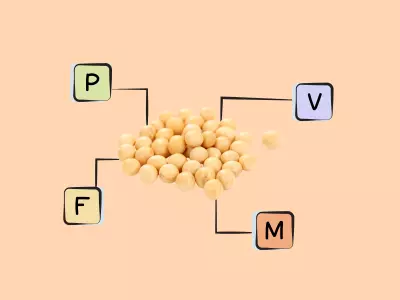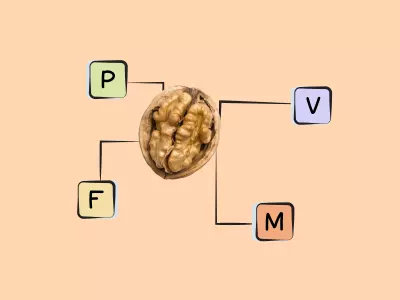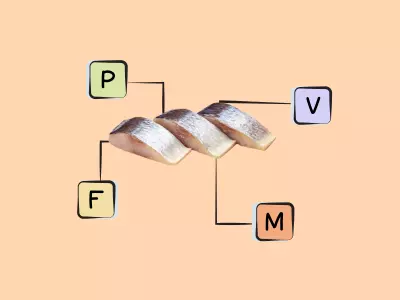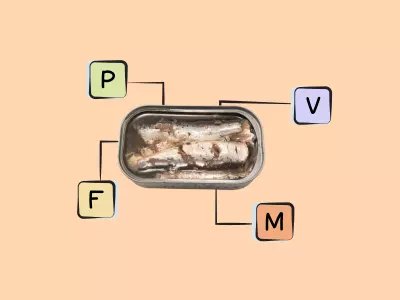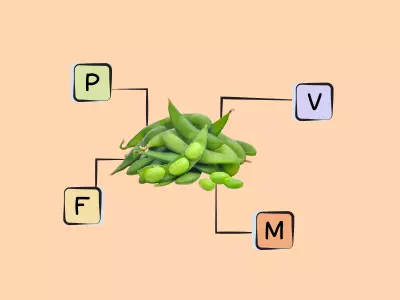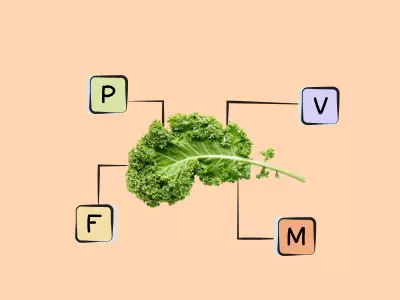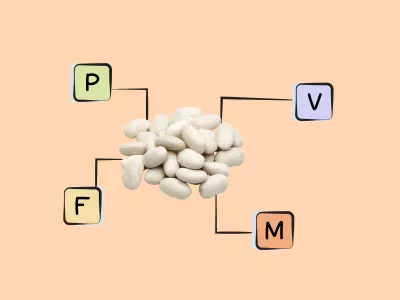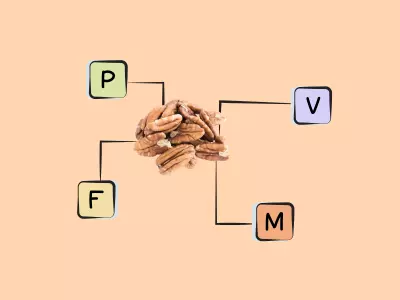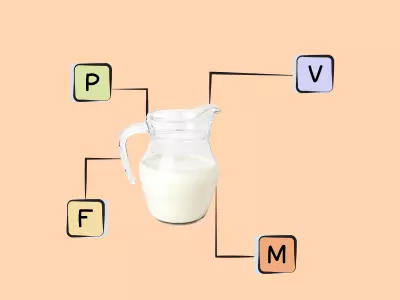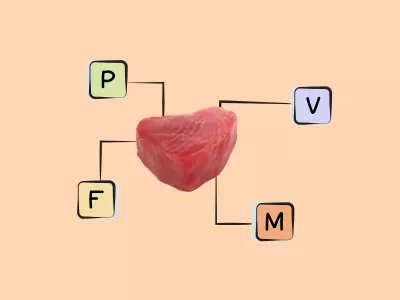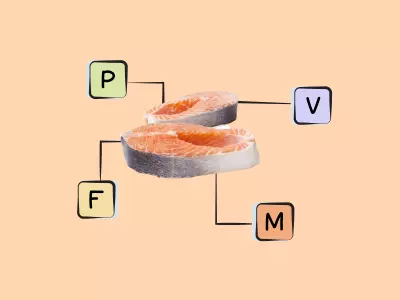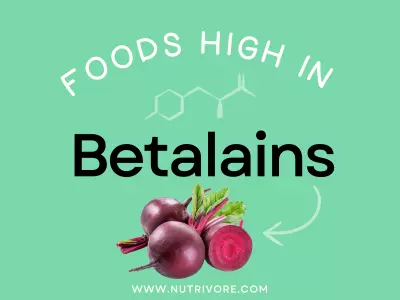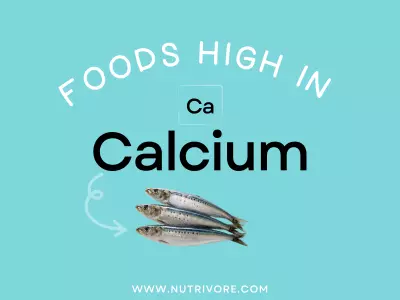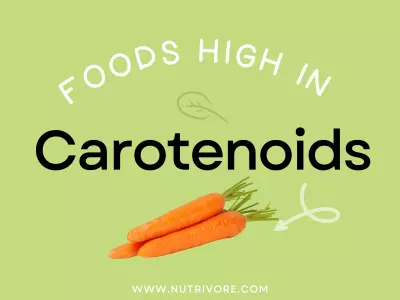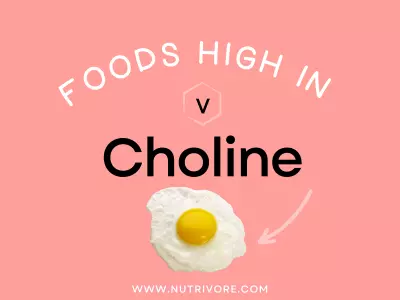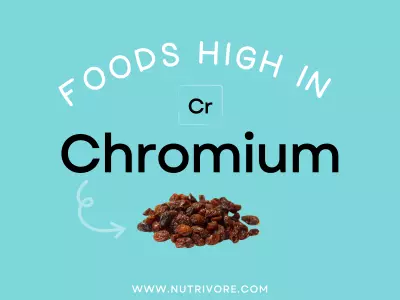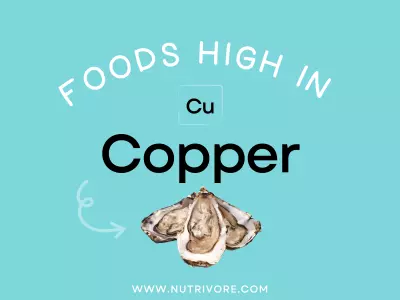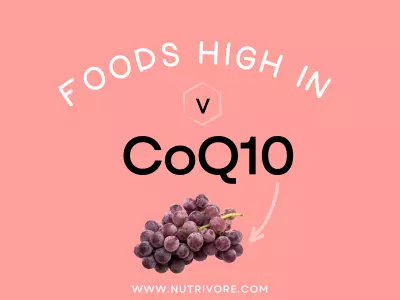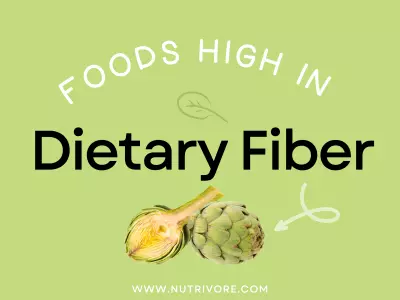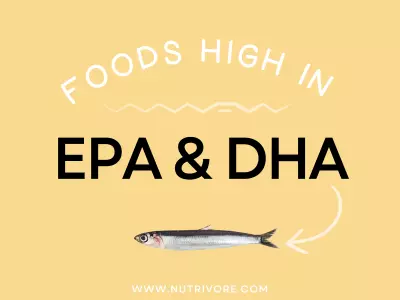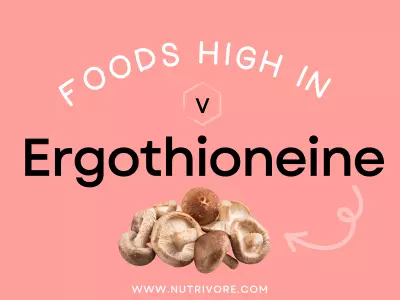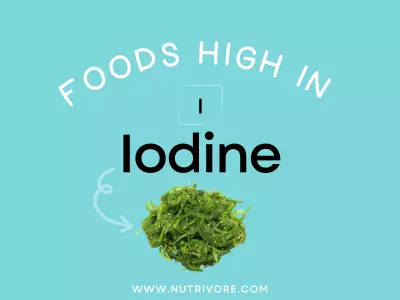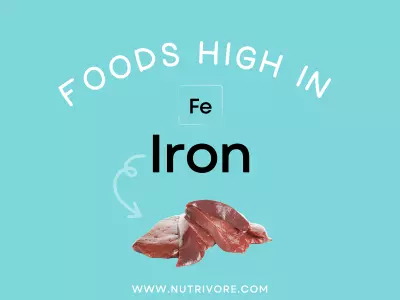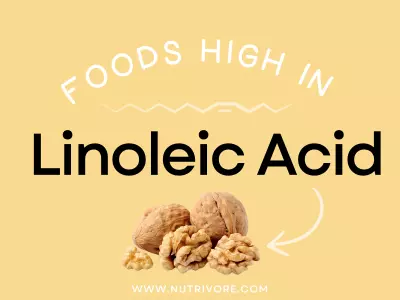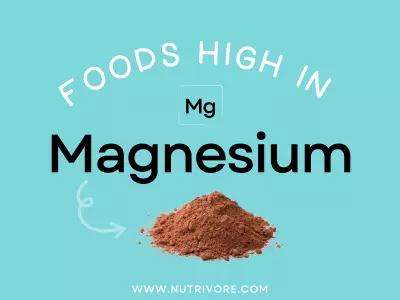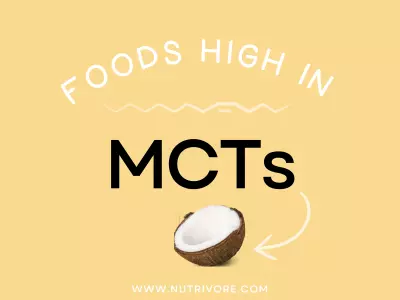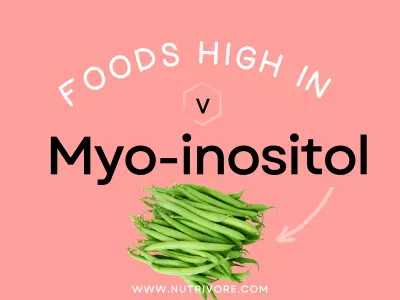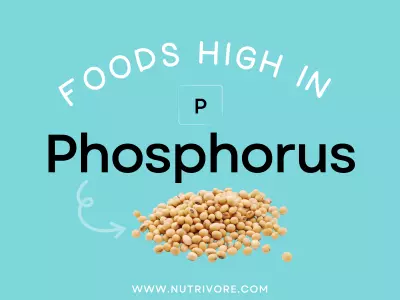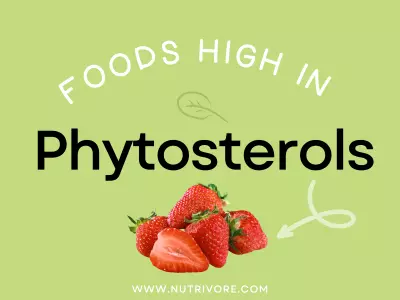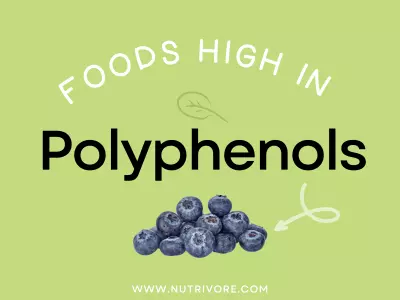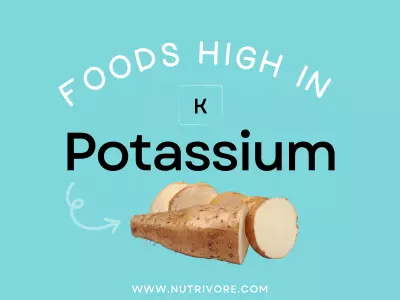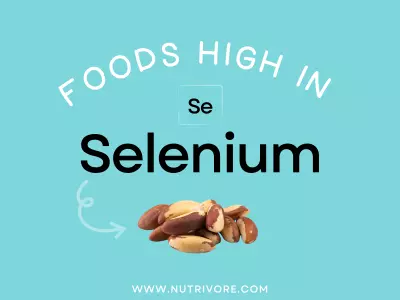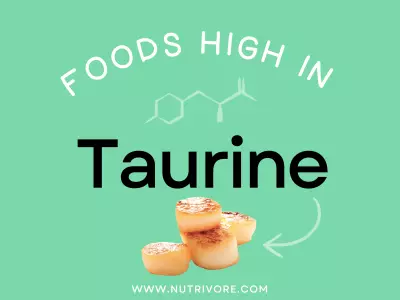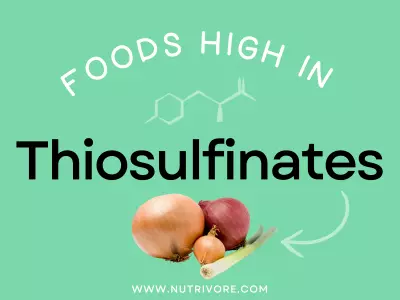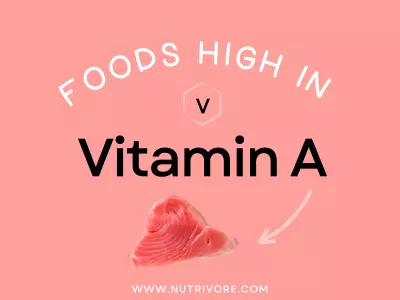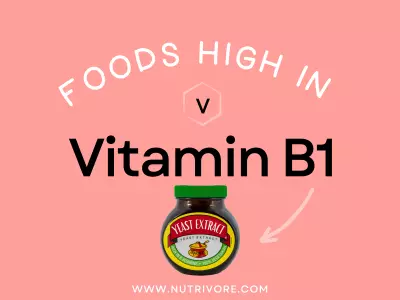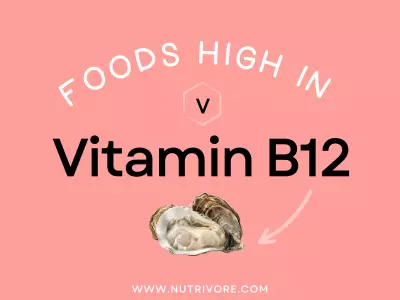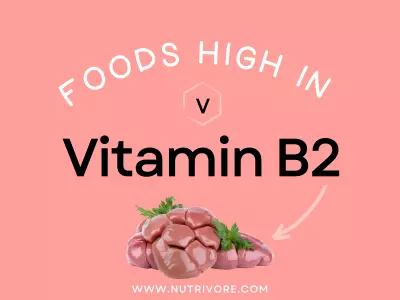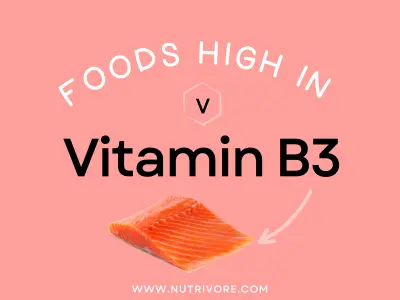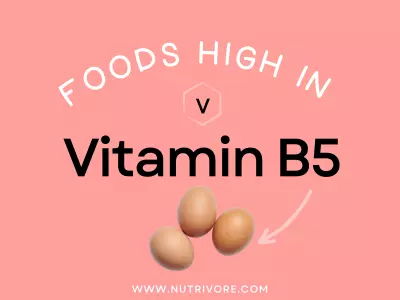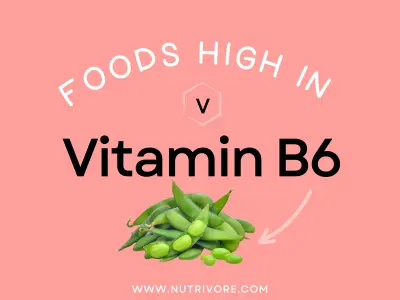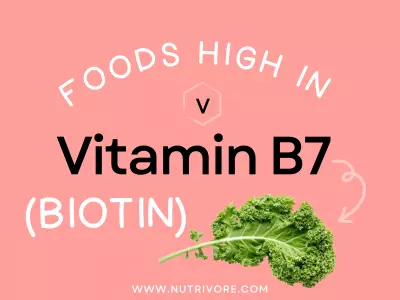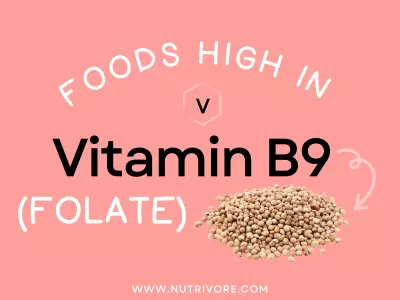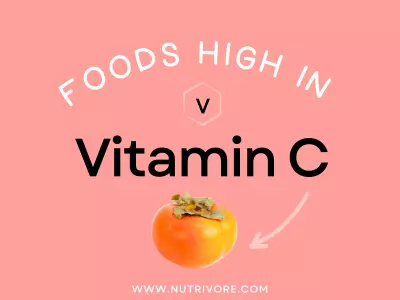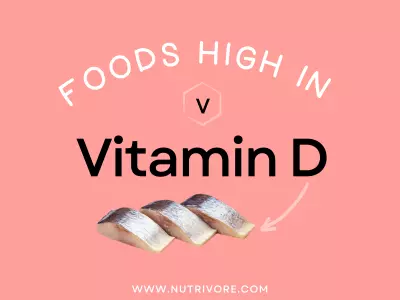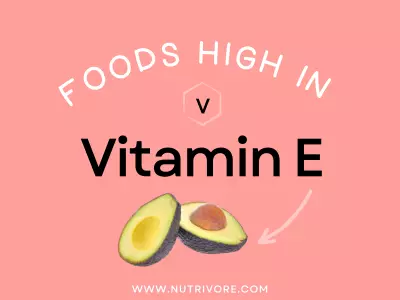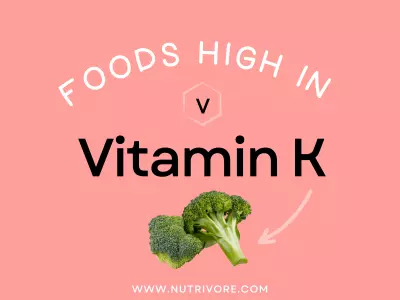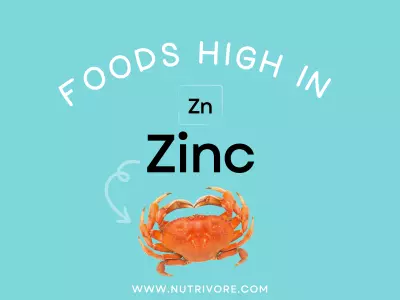Top 5 Common Food Sources of ALA
Looking to get more ALA in your diet? Look no further! My team and I have crunched the numbers and did all the math to determine the top 5 common food sources of this essential fatty acid, per serving. Getting enough ALA as part of a healthy balanced diet is important since a large collection of studies show that getting nutrients from dietary supplements or multivitamins doesn’t improve health outcomes compared to getting nutrients from foods!
| Rank | Food | Nutrivore Score | Serving Size (Raw) | ALA (g/serving) | % Daily Value |
|---|---|---|---|---|---|
| 1 | Flaxseed Oil, Cold-Pressed | 428 | 1 tbsp | 7.3 | 454 |
| 2 | Flaxseed | 515 | 1 oz / 28 g | 6.4 | 399 |
| 3 | Chia Seeds, Dried | 450 | 1 oz / 28 g | 5.0 | 312 |
| 4 | Hemp Seeds, Hulled | 415 | 1 oz / 28 g | 2.8 | 178 |
| 5 | Walnuts | 303 | 1 oz / 28 g | 2.5 | 159 |
Want to know more about this essential nutrient including the health effects of ALA, how much ALA we need, what happens if we have low ALA levels or if we get too much, and even more awesome ALA rich foods? Keep reading to learn all there is to know about this healthy fat!
Learn What Foods Are the Best Sources of Every Nutrient

The Top 25 Foods for Every Nutrient
The Top 25 Foods for Every Nutrient e-book is a well-organized, easy-to-use, grocery store-friendly guide to help you choose foods that fit your needs of 43 important nutrients while creating a balanced nutrient-dense diet.
Get two “Top 25” food lists for each nutrient, plus you’ll find RDA charts for everyone, informative visuals, fun facts, serving sizes and the 58 foods that are Nutrient Super Stars!
Buy now for instant digital access.
What Is ALA and What Does It Do?
Alpha-linolenic acid (ALA) is the only omega-3 fatty acid that’s truly essential, and is the most abundant omega-3 fat in most people’s diets. It’s an important component of the phospholipid layer of cell membranes, where it increases permeability and fluidity—in turn influencing cell membrane receptor systems and gene expression. Like other omega-3s, it helps form important signaling molecules called eicosanoids, which then help regulate inflammation, blood pressure, and pain perception.
Getting enough ALA is important for normal growth and development, as well as for modulating inflammatory responses. Along with playing a very protective role for cardiovascular health, it may help protect against some cancers, reduce certain forms of depression (including clinical depression and depression associated with multiple sclerosis), and reduce the risk of pneumonia. It even has antibacterial activity against H. pylori, the microbe that causes stomach ulcers!
Learn more about ALA here.
ALA Deficiency
True omega-3 deficiency is extremely rare because the body can release essential fatty acids from fat stores into circulation, even in cases of low intake or fat malabsorption disorders. This mechanism helps prevent acute deficiency, even on fat-restricted diets. For preventing deficiency, 0.2 to 0.3% of total calories consumed daily should be from ALA.
Groups At Risk
Documented omega-3 deficiency cases primarily occurred in the 1970s and 1980s due to parenteral nutrition lacking polyunsaturated fatty acids, combined with glucose solutions that inhibited essential fatty acid release from fat tissue.
Learn more here.
Symptoms of Deficiency
Symptoms of omega-3 deficiency include dry, scaly skin rashes and hair loss. Chronic omega-3 deficiency can also lead to numbness, leg pain, difficulty walking, poor growth in children, and blurred vision, but these side effects are rare. The primary concern with low omega-3 intake is an increased long-term risk of chronic health issues rather than acute symptoms; chronic issues include cardiovascular disease, inflammatory skin conditions, and obesity.
The effects of ALA deficiency are difficult to study due to its conversion into EPA and DHA, and it may not cause noticeable deficiency if EPA and DHA are obtained directly from dietary sources. Any issues linked to ALA deficiency are typically related to insufficient DHA, its primary end product.
Learn more here.
How Much ALA Do We Need?
The following table summarizes the current adequate intake recommendations for ALA based on age, gender, or situation. These intake recommendations should consider the significant individual differences in ALA conversion rates, as well as the amount of omega-6 in the diet. Generally, including ALA-rich foods like nuts, seeds, and fatty fish is sufficient to meet most people’s omega-3 requirements.
| 0 – 6 months | |||||
| 6 months to < 12 months | |||||
| 1 yr – 3 yrs | |||||
| 4 yrs – 8 yrs | |||||
| 9 yrs – 13 yrs | |||||
| 14 yrs – 18 yrs | |||||
| 19 yrs – 50 yrs | |||||
| 51+ yrs | |||||
| Pregnant (14 – 18 yrs) | |||||
| Pregnant (19 – 30 yrs) | |||||
| Pregnant (31 – 50 yrs) | |||||
| Lactating (14 – 18 yrs) | |||||
| Lactating (19 – 30 yrs) | |||||
| Lactating (31 – 50 yrs) |
Nutrient Daily Values
Nutrition requirements and recommended nutrient intake for infants, children, adolescents, adults, mature adults, and pregnant and lactating individuals.
More Food Sources of ALA
The best food sources of the plant-based omega-3 fatty acid ALA are flaxseed, hempseed, chia seeds, and their oils; it’s also found in nuts and other seeds, and in vegetable oils (like soybean oil and canola oil). Aside from these plant foods it is also found in oily fish such as sardines, eel, salmon, and tuna.
Best Food Sources of ALA
The following foods are the best sources of ALA, containing at least 0.8 grams or 50% of the recommended adequate intake per serving.
Good Food Sources of ALA
The following foods are excellent or good sources of omega-3 ALA, containing 0.16 grams up to 0.8 grams, or at least 10% (and up to 50%) of the recommended adequate intake per serving.
Top 5 Common Food Sources
If you’re looking for top 5 common food sources of other important nutrients check out these posts!
cITATIONS
Expand to see all scientific references for this article.
Abdelhamid AS, Brown TJ, Brainard JS, Biswas P, Thorpe GC, Moore HJ, Deane KH, Summerbell CD, Worthington HV, Song F, Hooper L. Omega-3 fatty acids for the primary and secondary prevention of cardiovascular disease. Cochrane Database Syst Rev. 2020 Feb 29;3(3):CD003177. doi: 10.1002/14651858.CD003177.pub5.
Ameur A, Enroth S, Johansson A, Zaboli G, Igl W, Johansson AC, Rivas MA, Daly MJ, Schmitz G, Hicks AA, Meitinger T, Feuk L, van Duijn C, Oostra B, Pramstaller PP, Rudan I, Wright AF, Wilson JF, Campbell H, Gyllensten U. Genetic adaptation of fatty-acid metabolism: a human-specific haplotype increasing the biosynthesis of long-chain omega-3 and omega-6 fatty acids. Am J Hum Genet. 2012 May 4;90(5):809-20. doi: 10.1016/j.ajhg.2012.03.014.
Arm JP, Boyce JA, Wang L, Chhay H, Zahid M, Patil V, Govindarajulu U, Ivester P, Weaver KL, Sergeant S, Israel E, Chilton FH. Impact of botanical oils on polyunsaturated fatty acid metabolism and leukotriene generation in mild asthmatics. Lipids Health Dis. 2013 Oct 2;12:141. doi: 10.1186/1476-511X-12-141.
Azrad M, Zhang K, Vollmer RT, Madden J, Polascik TJ, Snyder DC, Ruffin MT, Moul JW, Brenner D, Hardy RW, Demark-Wahnefried W. Prostatic alpha-linolenic acid (ALA) is positively associated with aggressive prostate cancer: a relationship which may depend on genetic variation in ALA metabolism. PLoS One. 2012;7(12):e53104. doi: 10.1371/journal.pone.0053104.
Blondeau N, Lipsky RH, Bourourou M, Duncan MW, Gorelick PB, Marini AM. Alpha-linolenic acid: an omega-3 fatty acid with neuroprotective properties-ready for use in the stroke clinic? Biomed Res Int. 2015;2015:519830. doi: 10.1155/2015/519830.
Blondeau N, Widmann C, Lazdunski M, Heurteaux C. Polyunsaturated fatty acids induce ischemic and epileptic tolerance. Neuroscience. 2002;109(2):231-41. doi: 10.1016/s0306-4522(01)00473-0.
Bougnoux P, Koscielny S, Chajès V, Descamps P, Couet C, Calais G. alpha-Linolenic acid content of adipose breast tissue: a host determinant of the risk of early metastasis in breast cancer. Br J Cancer. 1994 Aug;70(2):330-4. doi: 10.1038/bjc.1994.302.
Brouwer IA, Geleijnse JM, Klaasen VM, Smit LA, Giltay EJ, de Goede J, Heijboer AC, Kromhout D, Katan MB. Effect of alpha linolenic acid supplementation on serum prostate specific antigen (PSA): results from the alpha omega trial. PLoS One. 2013 Dec 11;8(12):e81519. doi: 10.1371/journal.pone.0081519.
Burdge G. Alpha-linolenic acid metabolism in men and women: nutritional and biological implications. Curr Opin Clin Nutr Metab Care. 2004 Mar;7(2):137-44. doi: 10.1097/00075197-200403000-00006.
Burdge GC, Jones AE, Wootton SA. Eicosapentaenoic and docosapentaenoic acids are the principal products of alpha-linolenic acid metabolism in young men*. Br J Nutr. 2002 Oct;88(4):355-63. doi: 10.1079/BJN2002662.
Burdge GC, Wootton SA. Conversion of alpha-linolenic acid to eicosapentaenoic, docosapentaenoic and docosahexaenoic acids in young women. Br J Nutr. 2002 Oct;88(4):411-20. doi: 10.1079/BJN2002689.
Burdge GC. Metabolism of alpha-linolenic acid in humans. Prostaglandins Leukot Essent Fatty Acids. 2006 Sep;75(3):161-8. doi: 10.1016/j.plefa.2006.05.013.
Burns T, Maciejewski SR, Hamilton WR, Zheng M, Mooss AN, Hilleman DE. Effect of omega-3 fatty acid supplementation on the arachidonic acid:eicosapentaenoic acid ratio. Pharmacotherapy. 2007 May;27(5):633-8. doi: 10.1592/phco.27.5.633.
Butler LM, Yuan JM, Huang JY, Su J, Wang R, Koh WP, Ong CN. Plasma fatty acids and risk of colon and rectal cancers in the Singapore Chinese Health Study. NPJ Precis Oncol. 2017 Nov 23;1(1):38. doi: 10.1038/s41698-017-0040-z.
Calder PC. n-3 fatty acids, inflammation and immunity: new mechanisms to explain old actions. Proc Nutr Soc. 2013 Aug;72(3):326-36. doi: 10.1017/S0029665113001031.
Calder PC. Polyunsaturated fatty acids and inflammatory processes: New twists in an old tale. Biochimie. 2009 Jun;91(6):791-5. doi: 10.1016/j.biochi.2009.01.008.
Chajès V, Sattler W, Stranzl A, Kostner GM. Influence of n-3 fatty acids on the growth of human breast cancer cells in vitro: relationship to peroxides and vitamin-E. Breast Cancer Res Treat. 1995 Jun;34(3):199-212. doi: 10.1007/BF00689711.
Chamberland JP, Moon HS. Down-regulation of malignant potential by alpha linolenic acid in human and mouse colon cancer cells9. Fam Cancer. 2015 Mar;14(1):25-30. doi: 10.1007/s10689-014-9762-z.
Chen LH, Hu Q, Li G, Zhang L, Qin LQ, Zuo H, Xu G. Dietary Intake and Biomarkers of α-Linolenic Acid and Mortality: A Meta-Analysis of Prospective Cohort Studies. Front Nutr. 2021 Nov 3;8:743852. doi: 10.3389/fnut.2021.743852.
Christensen JH, Fabrin K, Borup K, Barber N, Poulsen J. Prostate tissue and leukocyte levels of n-3 polyunsaturated fatty acids in men with benign prostate hyperplasia or prostate cancer. BJU Int. 2006 Feb;97(2):270-3. doi: 10.1111/j.1464-410X.2006.05951.x.
Davidson MH. Omega-3 fatty acids: new insights into the pharmacology and biology of docosahexaenoic acid, docosapentaenoic acid, and eicosapentaenoic acid. Curr Opin Lipidol. 2013 Dec;24(6):467-74. doi: 10.1097/MOL.0000000000000019.
de Goede J, Verschuren WM, Boer JM, Kromhout D, Geleijnse JM. Alpha-linolenic acid intake and 10-year incidence of coronary heart disease and stroke in 20,000 middle-aged men and women in the Netherlands. PLoS One. 2011 Mar 25;6(3):e17967. doi: 10.1371/journal.pone.0017967.
de Lorgeril M, Salen P. The Mediterranean diet in secondary prevention of coronary heart disease. Clin Invest Med. 2006 Jun;29(3):154-8.
Del Gobbo LC, Imamura F, Aslibekyan S, Marklund M, Virtanen JK, Wennberg M, Yakoob MY, Chiuve SE, Dela Cruz L, Frazier-Wood AC, Fretts AM, Guallar E, Matsumoto C, Prem K, Tanaka T, Wu JH, Zhou X, Helmer C, Ingelsson E, Yuan JM, Barberger-Gateau P, Campos H, Chaves PH, Djoussé L, Giles GG, Gómez-Aracena J, Hodge AM, Hu FB, Jansson JH, Johansson I, Khaw KT, Koh WP, Lemaitre RN, Lind L, Luben RN, Rimm EB, Risérus U, Samieri C, Franks PW, Siscovick DS, Stampfer M, Steffen LM, Steffen BT, Tsai MY, van Dam RM, Voutilainen S, Willett WC, Woodward M, Mozaffarian D; Cohorts for Heart and Aging Research in Genomic Epidemiology (CHARGE) Fatty Acids and Outcomes Research Consortium (FORCe). ω-3 Polyunsaturated Fatty Acid Biomarkers and Coronary Heart Disease: Pooling Project of 19 Cohort Studies. JAMA Intern Med. 2016 Aug 1;176(8):1155-66. doi: 10.1001/jamainternmed.2016.2925.
Djoussé L, Arnett DK, Pankow JS, Hopkins PN, Province MA, Ellison RC. Dietary linolenic acid is associated with a lower prevalence of hypertension in the NHLBI Family Heart Study. Hypertension. 2005 Mar;45(3):368-73. doi: 10.1161/01.HYP.0000154679.41568.e6.
Djoussé L, Folsom AR, Province MA, Hunt SC, Ellison RC; National Heart, Lung, and Blood Institute Family Heart Study. Dietary linolenic acid and carotid atherosclerosis: the National Heart, Lung, and Blood Institute Family Heart Study. Am J Clin Nutr. 2003 Apr;77(4):819-25. doi: 10.1093/ajcn/77.4.819.
Djoussé L, Hunt SC, Arnett DK, Province MA, Eckfeldt JH, Ellison RC. Dietary linolenic acid is inversely associated with plasma triacylglycerol: the National Heart, Lung, and Blood Institute Family Heart Study. Am J Clin Nutr. 2003 Dec;78(6):1098-102. doi: 10.1093/ajcn/78.6.1098.
Djoussé L, Rautaharju PM, Hopkins PN, Whitsel EA, Arnett DK, Eckfeldt JH, Province MA, Ellison RC; Investigators of the NHLBI Family Heart Study. Dietary linolenic acid and adjusted QT and JT intervals in the National Heart, Lung, and Blood Institute Family Heart study. J Am Coll Cardiol. 2005 May 17;45(10):1716-22. doi: 10.1016/j.jacc.2005.01.060.
Dugani A, Auzzi A, Naas F, Megwez S. Effects of the oil and mucilage from flaxseed (linum usitatissimum) on gastric lesions induced by ethanol in rats. Libyan J Med. 2008 Dec 1;3(4):166-9. doi: 10.4176/080612.
Egert S, Kannenberg F, Somoza V, Erbersdobler HF, Wahrburg U. Dietary alpha-linolenic acid, EPA, and DHA have differential effects on LDL fatty acid composition but similar effects on serum lipid profiles in normolipidemic humans. J Nutr. 2009 May;139(5):861-8. doi: 10.3945/jn.108.103861.
Hanson S, Thorpe G, Winstanley L, Abdelhamid AS, Hooper L; PUFAH group. Omega-3, omega-6 and total dietary polyunsaturated fat on cancer incidence: systematic review and meta-analysis of randomised trials. Br J Cancer. 2020 Apr;122(8):1260-1270. doi: 10.1038/s41416-020-0761-6.
Harris WS, Sands SA, Windsor SL, Ali HA, Stevens TL, Magalski A, Porter CB, Borkon AM. Omega-3 fatty acids in cardiac biopsies from heart transplantation patients: correlation with erythrocytes and response to supplementation. Circulation. 2004 Sep 21;110(12):1645-9. doi: 10.1161/01.CIR.0000142292.
Harris WS, Tintle NL, Imamura F, Qian F, Korat AVA, Marklund M, Djoussé L, Bassett JK, Carmichael PH, Chen YY, Hirakawa Y, Küpers LK, Laguzzi F, Lankinen M, Murphy RA, Samieri C, Senn MK, Shi P, Virtanen JK, Brouwer IA, Chien KL, Eiriksdottir G, Forouhi NG, Geleijnse JM, Giles GG, Gudnason V, Helmer C, Hodge A, Jackson R, Khaw KT, Laakso M, Lai H, Laurin D, Leander K, Lindsay J, Micha R, Mursu J, Ninomiya T, Post W, Psaty BM, Risérus U, Robinson JG, Shadyab AH, Snetselaar L, Sala-Vila A, Sun Y, Steffen LM, Tsai MY, Wareham NJ, Wood AC, Wu JHY, Hu F, Sun Q, Siscovick DS, Lemaitre RN, Mozaffarian D; Fatty Acids and Outcomes Research Consortium (FORCE). Blood n-3 fatty acid levels and total and cause-specific mortality from 17 prospective studies. Nat Commun. 2021 Apr 22;12(1):2329. doi: 10.1038/s41467-021-22370-2.
Hsiao WT, Su HM, Su KP, Chen SH, Wu HP, You YL, Fu RH, Chao PM. Deficiency or activation of peroxisome proliferator-activated receptor α reduces the tissue concentrations of endogenously synthesized docosahexaenoic acid in C57BL/6J mice. Nutr Res Pract. 2019 Aug;13(4):286-294. doi: 10.4162/nrp.2019.13.4.286.
Jelinek GA, Hadgkiss EJ, Weiland TJ, Pereira NG, Marck CH, van der Meer DM. Association of fish consumption and Ω 3 supplementation with quality of life, disability and disease activity in an international cohort of people with multiple sclerosis. Int J Neurosci. 2013 Nov;123(11):792-800. doi: 10.3109/00207454.2013.803104.
Jeppesen PB, Høy CE, Mortensen PB. Deficiencies of essential fatty acids, vitamin A and E and changes in plasma lipoproteins in patients with reduced fat absorption or intestinal failure. Eur J Clin Nutr. 2000 Aug;54(8):632-42. doi: 10.1038/sj.ejcn.1601067.
Jump DB, Tripathy S, Depner CM. Fatty acid-regulated transcription factors in the liver. Annu Rev Nutr. 2013;33:249-69. doi: 10.1146/annurev-nutr-071812-161139.
Kaithwas G, Majumdar DK. Therapeutic effect of Linum usitatissimum (flaxseed/linseed) fixed oil on acute and chronic arthritic models in albino rats. Inflammopharmacology. 2010 Jun;18(3):127-36. doi: 10.1007/s10787-010-0033-9.
Kitson AP, Stroud CK, Stark KD. Elevated production of docosahexaenoic acid in females: potential molecular mechanisms. Lipids. 2010 Mar;45(3):209-24. doi: 10.1007/s11745-010-3391-6.
Klein V, Chajès V, Germain E, Schulgen G, Pinault M, Malvy D, Lefrancq T, Fignon A, Le Floch O, Lhuillery C, Bougnoux P. Low alpha-linolenic acid content of adipose breast tissue is associated with an increased risk of breast cancer. Eur J Cancer. 2000 Feb;36(3):335-40. doi: 10.1016/s0959-8049(99)00254-3.
Krauss RM, Eckel RH, Howard B, Appel LJ, Daniels SR, Deckelbaum RJ, Erdman JW Jr, Kris-Etherton P, Goldberg IJ, Kotchen TA, Lichtenstein AH, Mitch WE, Mullis R, Robinson K, Wylie-Rosett J, St Jeor S, Suttie J, Tribble DL, Bazzarre TL. AHA Dietary Guidelines: revision 2000: A statement for healthcare professionals from the Nutrition Committee of the American Heart Association. Circulation. 2000 Oct 31;102(18):2284-99. doi: 10.1161/01.cir.102.18.2284.
Lee TC, Ivester P, Hester AG, Sergeant S, Case LD, Morgan T, Kouba EO, Chilton FH. The impact of polyunsaturated fatty acid-based dietary supplements on disease biomarkers in a metabolic syndrome/diabetes population. Lipids Health Dis. 2014 Dec 16;13:196. doi: 10.1186/1476-511X-13-196.
Liu J, Ma DW. The role of n-3 polyunsaturated fatty acids in the prevention and treatment of breast cancer. Nutrients. 2014 Nov 18;6(11):5184-223. doi: 10.3390/nu6115184.
Lucas M, Mirzaei F, O’Reilly EJ, Pan A, Willett WC, Kawachi I, Koenen K, Ascherio A. Dietary intake of n-3 and n-6 fatty acids and the risk of clinical depression in women: a 10-y prospective follow-up study. Am J Clin Nutr. 2011 Jun;93(6):1337-43. doi: 10.3945/ajcn.111.011817.
Mathias RA, Pani V, Chilton FH. Genetic Variants in the FADS Gene: Implications for Dietary Recommendations for Fatty Acid Intake. Curr Nutr Rep. 2014 Jun;3(2):139-148. doi: 10.1007/s13668-014-0079-1.
McNamara RK, Almeida DM. Omega-3 Polyunsaturated Fatty Acid Deficiency and Progressive Neuropathology in Psychiatric Disorders: A Review of Translational Evidence and Candidate Mechanisms. Harv Rev Psychiatry. 2019 Mar/Apr;27(2):94-107. doi: 10.1097/HRP.0000000000000199.
Merchant AT, Curhan GC, Rimm EB, Willett WC, Fawzi WW. Intake of n-6 and n-3 fatty acids and fish and risk of community-acquired pneumonia in US men. Am J Clin Nutr. 2005 Sep;82(3):668-74. doi: 10.1093/ajcn.82.3.668.
Miura K, Way M, Jiyad Z, Marquart L, Plasmeijer EI, Campbell S, Isbel N, Fawcett J, Ferguson LE, Davis M, Whiteman DC, Soyer HP, O’Rourke P, Green AC. Omega-3 fatty acid intake and decreased risk of skin cancer in organ transplant recipients. Eur J Nutr. 2021 Jun;60(4):1897-1905. doi: 10.1007/s00394-020-02378-y.
Moon HS, Batirel S, Mantzoros CS. Alpha linolenic acid and oleic acid additively down-regulate malignant potential and positively cross-regulate AMPK/S6 axis in OE19 and OE33 esophageal cancer cells. Metabolism. 2014 Nov;63(11):1447-54. doi: 10.1016/j.metabol.2014.07.009.
Naghshi S, Aune D, Beyene J, Mobarak S, Asadi M, Sadeghi O. Dietary intake and biomarkers of alpha linolenic acid and risk of all cause, cardiovascular, and cancer mortality: systematic review and dose-response meta-analysis of cohort studies. BMJ. 2021 Oct 13;375:n2213. doi: 10.1136/bmj.n2213.
Patterson E, Wall R, Fitzgerald GF, Ross RP, Stanton C. Health implications of high dietary omega-6 polyunsaturated Fatty acids. J Nutr Metab. 2012;2012:539426. doi: 10.1155/2012/539426.
Rajaram S. Health benefits of plant-derived α-linolenic acid. Am J Clin Nutr. 2014 Jul;100 Suppl 1:443S-8S. doi: 10.3945/ajcn.113.071514.
Saito S, Fukuhara I, Osaki N, Nakamura H, Katsuragi Y. Consumption of alpha-Linolenic Acid-enriched Diacylglycerol Reduces Visceral Fat Area in Overweight and Obese Subjects: a Randomized, Double-blind Controlled, Parallel-group Designed Trial. J Oleo Sci. 2016 Jul 1;65(7):603-11. doi: 10.5650/jos.ess16059.
Simopoulos AP. An Increase in the Omega-6/Omega-3 Fatty Acid Ratio Increases the Risk for Obesity. Nutrients. 2016 Mar 2;8(3):128. doi: 10.3390/nu8030128.
Soleimani Z, Hashemdokht F, Bahmani F, Taghizadeh M, Memarzadeh MR, Asemi Z. Clinical and metabolic response to flaxseed oil omega-3 fatty acids supplementation in patients with diabetic foot ulcer: A randomized, double-blind, placebo-controlled trial. J Diabetes Complications. 2017 Sep;31(9):1394-1400. doi: 10.1016/j.jdiacomp.2017.06.010.
Stark AH, Reifen R, Crawford MA. Past and Present Insights on Alpha-linolenic Acid and the Omega-3 Fatty Acid Family. Crit Rev Food Sci Nutr. 2016 Oct 25;56(14):2261-7. doi: 10.1080/10408398.2013.828678.
Stegink LD, Freeman JB, Wispe J, Connor WE. Absence of the biochemical symptoms of essential fatty acid deficiency in surgical patients undergoing protein sparing therapy. Am J Clin Nutr. 1977 Mar;30(3):388-93. doi: 10.1093/ajcn/30.3.388.
Stillwell W, Wassall SR. Docosahexaenoic acid: membrane properties of a unique fatty acid. Chem Phys Lipids. 2003 Nov;126(1):1-27. doi: 10.1016/s0009-3084(03)00101-4.
Taylor KL, Hadgkiss EJ, Jelinek GA, Weiland TJ, Pereira NG, Marck CH, van der Meer DM. Lifestyle factors, demographics and medications associated with depression risk in an international sample of people with multiple sclerosis. BMC Psychiatry. 2014 Dec 3;14:327. doi: 10.1186/s12888-014-0327-3.
Thompson L, Cockayne A, Spiller RC. Inhibitory effect of polyunsaturated fatty acids on the growth of Helicobacter pylori: a possible explanation of the effect of diet on peptic ulceration. Gut. 1994 Nov;35(11):1557-61. doi: 10.1136/gut.35.11.1557.
Thompson LU, Chen JM, Li T, Strasser-Weippl K, Goss PE. Dietary flaxseed alters tumor biological markers in postmenopausal breast cancer. Clin Cancer Res. 2005 May 15;11(10):3828-35. doi: 10.1158/1078-0432.CCR-04-2326.
Tosi F, Sartori F, Guarini P, Olivieri O, Martinelli N. Delta-5 and delta-6 desaturases: crucial enzymes in polyunsaturated fatty acid-related pathways with pleiotropic influences in health and disease. Adv Exp Med Biol. 2014;824:61-81. doi: 10.1007/978-3-319-07320-0_7.
Truan JS, Chen JM, Thompson LU. Flaxseed oil reduces the growth of human breast tumors (MCF-7) at high levels of circulating estrogen. Mol Nutr Food Res. 2010 Oct;54(10):1414-21. doi: 10.1002/mnfr.200900521.
Wei J, Hou R, Xi Y, Kowalski A, Wang T, Yu Z, Hu Y, Chandrasekar EK, Sun H, Ali MK. The association and dose-response relationship between dietary intake of α-linolenic acid and risk of CHD: a systematic review and meta-analysis of cohort studies. Br J Nutr. 2018 Jan;119(1):83-89. doi: 10.1017/S0007114517003294.
Weiland TJ, Jelinek GA, Marck CH, Hadgkiss EJ, van der Meer DM, Pereira NG, Taylor KL. Clinically significant fatigue: prevalence and associated factors in an international sample of adults with multiple sclerosis recruited via the internet. PLoS One. 2015 Feb 18;10(2):e0115541. doi: 10.1371/journal.pone.0115541.
Wilkinson P, Leach C, Ah-Sing EE, Hussain N, Miller GJ, Millward DJ, Griffin BA. Influence of alpha-linolenic acid and fish-oil on markers of cardiovascular risk in subjects with an atherogenic lipoprotein phenotype. Atherosclerosis. 2005 Jul;181(1):115-24. doi: 10.1016/j.atherosclerosis.2004.12.029.
Zuliani G, Galvani M, Leitersdorf E, Volpato S, Cavalieri M, Fellin R. The role of polyunsaturated fatty acids (PUFA) in the treatment of dyslipidemias. Curr Pharm Des. 2009;15(36):4087-93. doi: 10.2174/138161209789909773.



